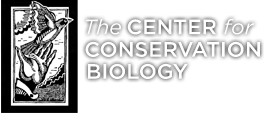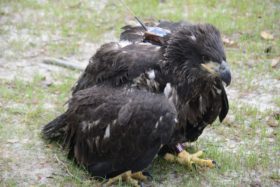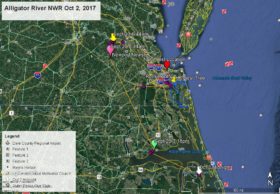Mate Selection by Bald Eagles
Camellia Visits NBG – Spends The Night
February 18, 2011Camellia in Lake Shores in VB
February 21, 2011
No easy answer for these often asked questions. How do bald eagles choose their mate? Does the female or male make the decision? Is there competition? How can they recognize each other from such long distances away? While the subject of mate selection has been well studied in many species, I have not found any published studies of mate selection by the bald eagle, and my colleagues at the Center for Conservation Biology have the same answer that I have – I don’t know!
However, there are several clues even if we don’t know for certain. Charles Darwin was the first to suggest in his 1859 The Origin of Species that sexual dichromatism – one sex brightly colored the other drab – played a role in choosing a mate. For the most part his theories were rejected for many years. I expect that most viewers of the WVEC web cam at Norfolk Botanical Garden have seen nature programs on television of brightly colored males dancing or displaying in front of one or more drably colored females as part of the mate selection process. Both the male and female bald eagle look alike so is color a factor? Probably not. Perhaps size is a factor since the male is always smaller. How about display? Bald eagles are well known for their “courtship flights” sometimes called sky-dancing. Locking talons and tumbling down together is often observed. In December 1992 the then only known pair of bald eagles in Virginia Beach locked talons and fell into Atlantic Ave where they were covered with a blanket by a motorist until animal control officers arrived to get them unlocked. Neither eagle was injured and flew off. Is there competition? A few years later three bald eagles fell out of the sky locked together into a mans yard in Thoroughgood in Virginia Beach as he worked in his yard. One eagle flew off immediately, one flew off after resting a few minutes, and the other waited until I got there with a reporter from the newspaper. Was it two males after the same lady? Two ladies after the same guy? Don’t know, but maybe. Who makes the selection? Most studies have determined that it is the female, however that is not always the case. One study of barn owls in Europe determined that the male made the selection based on very minor color differences in breast feathers on the female. Birds are highly visually sensitive, but sounds can also be a factor in identification. I have been in hugh colonies of several species of penguins and they locate each other by the sounds they make. Visitors at Norfolk Botanical Garden have noticed that the pitch of the voice of the male and female is different. Is this another factor in mate secection? Possible!
So where does that leave us as far as an answer? Perhaps ornithologist and professor of biology Geoffrey E. Hill states it best in his book Bird Coloration – A simple visual signal that says “I am a male” or “I am a female” says it all.




6 Comments
Thank you for this information, Reese. Fascinating.
I agree…fascinating! Thank you.
Dont know how it happened or who made the decision but our pair chose well no matter who decided or for what reason.
So we just don’t know!
If selection is just basically chance and opportunity,I’d say our NBG pair have adapted well to each other and the shared responsibilities of successful reproduction and raising of offspring! They are amazing to watch.
Thanks, Reese…
chicadee
I think I know the reason why eagles choose who they do as a mate: it’s not like you’re going to meet a better looking eagle. Ok, ok, bad joke. I’d like to suggest it’s something with scent – studies have suggested that women can recognize the scent of their children’s specfic hair, and clothes. There have also been studies of rare household dogs who have the odd talent for sniffing out tumors on people, or a change in a diabetic’s sugar level spike. Chemicals are such an amazing marker, everyone and everything has one. All it has to be is a few molecules different to make a different scent. I’m thinking that us boring humans don’t even know the half of how it goes, with our limited noses
Response – Birds in general have a very poor sense of smell. Turkey vultures are an exception, with an excellent sense of smell. That is what they are doing when we see them rock back and forth in the air – smelling for decaying prey. Eagles are not equiped with a very good sense of smell,
Thanks for the interesting information! Any idea if they choose mates before reaching maturity (5 years old)? I ask because I’ve noticed a pair of juvenile bald eagles along the Oswego River in central New York (about 30 miles north of Syracuse, NY). They seem to behave like a pair, even though they do not yet have white heads. One is clearly larger than the other, so I think they are a female and male pair.
Response – Four years old eagles have been known to at least attempt to court another eagle.